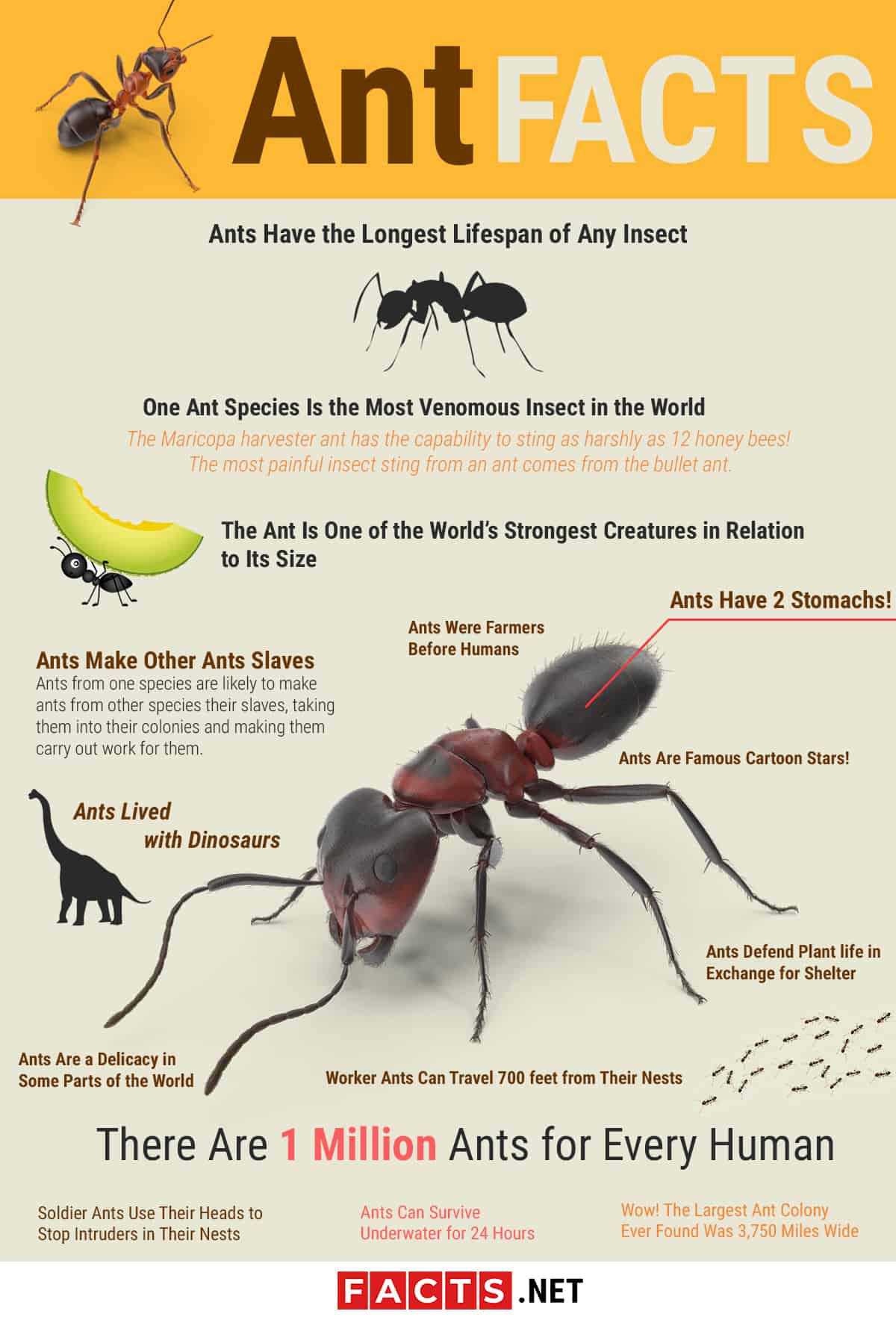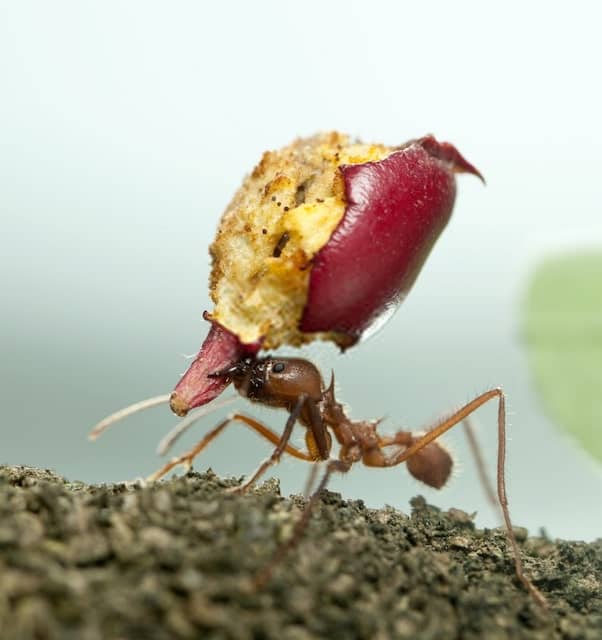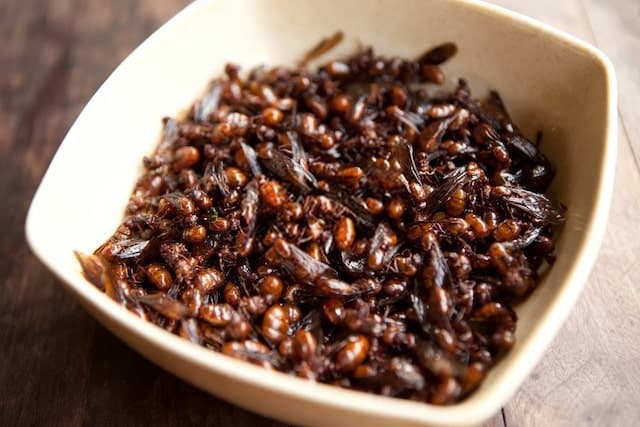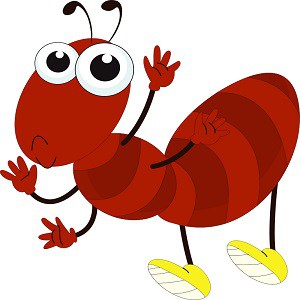
- Types: Over 12,000 different types worldwide
- Lifespan: Anything up to 15 years
- Do Ants have Brains: Yes, an ant brain has 250,000 brain cells
- Name: Derives from Middle English word “ante”
- Evolved: From wasps
- Species: Hymenoptera
- Subspecies: Apocrita
- Size: Between 0.07-2 inches
- Classification: Insecta
- Indigenous to: Everywhere in the world, except Antarctica
- Biology: Ants Have the Longest Lifespan of Any Insect
- Wildlife: One Ant Species Is the Most Venomous Insect in the World
- Wildlife: The Ant Is One of the World’s Strongest Creatures in Relation to Its Size
- Biology: Ants Have 2 Stomachs!
- Wildlife: Ants Make Other Ants Slaves
- History: Ants Lived with Dinosaurs
- Entertainment: Ants Are Famous Cartoon Stars!
- History: Ants Defend Plant life in Exchange for Shelter
- Food: Ants Are a Delicacy in Some Parts of the World
- History: Ants Were Farmers Before Humans
- Worker Ants can travel 700 feet from their nests
- Astonishing! There are 1 million Ants for every Human
- Soldier Ants use their heads to stop intruders in their nests
- Ants can survive underwater for 24 hours
- Wow! The largest Ant colony ever found was 3,750 miles wide
Ant Facts Infographics

Ants Have the Longest Lifespan of Any Insect
The first of our interesting ant facts tells us a little about how long they can live. While it is true that some species can live for up to 15 years, there is one particular ant that was recorded as living for 30 years! This was a queen ant, and she lived in her natural habitat in Idaho for the entire span of her life. The queen ant, much like the queen bee, is the founder of the colony. Once she has been fertilised she can lay millions of eggs over time.
One Ant Species Is the Most Venomous Insect in the World
We know that ants can nip and bite, and we know how nasty that can be. However, there is one species of ant that is not only the most venomous amongst its own kind, but also the most venomous insect in the world. The Maricopa harvester ant has the capability to sting as harshly as 12 honey bees! The most painful insect sting from an ant comes from the bullet ant.
The Ant Is One of the World’s Strongest Creatures in Relation to Its Size

The next in our series of fascinating ant facts tells us just how strong they can be. It is estimated that ants can carry up to 50 times their own body weight. They are often seen working together to try and move heavy objects from place to place. They can also move as much as 50 tons of soil from one location to another over the course of one year. Some ecologists believe that this makes them more important than earthworms in this regard.
Ants Have 2 Stomachs!
When ants have been observed in the wild, it may sometimes appear that they are kissing each other. Whilst this is a sweet notion, it isn’t actually true! They are actually feeding each other from one of their 2 stomachs. They have 1 stomach which they use to feed themselves, and another which they use to nurture others. The process of ants feeding each other from their second stomach is called trophallaxis and it means that groups of ants can split into 2, with one half staying in the nest and the other going out to forage for food.
Ants Make Other Ants Slaves
Ants from one species are likely to make ants from other species their slaves, taking them into their colonies and making them carry out work for them. One species, the honeypot ant will enslave its own kind to work for it – and sometimes make ants from other foreign colonies do their bidding.
Ants Lived with Dinosaurs
This next in our ant facts series shows us exactly how long they have been roaming the Earth! They evolved some 130 million years ago, and fossilised remains of insects dating back to 92 million years ago have been found in resin and amber. The oldest known ant species is called sphercomyrma freyi and was found in Clifford Beach, New Jersey.
Ants Are Famous Cartoon Stars!
In 1998, ants got their own animated movie called Antz, which was set in an ant colony in Central Park, New York. It’s famous for being the first CGI film to be made by DreamWorks, and also for being only the second feature length computer animated film. It features a cast of ants that were created to look, in some ways, like the famous people that voiced them, such as Sylvester Stallone and Woody Allen.
Ants Defend Plant life in Exchange for Shelter
Special types of plants called Myrmecophytes have secret hollows or places in which ants can burrow for safety and shelter. These places might look like thorns or hollow stems. The ants, in return for this shelter, will protect the plant from intruders, from infestation and from being eaten by other insects or animals.
Ants Are a Delicacy in Some Parts of the World

This next of our ant facts might be a bit gross for some – but ants and ant pupae (their eggs) are considered a delicacy in some parts of the world. In places such as India, the pupae of ants can sell for as much as $40 per pound. In the Far East, green weaver ants are used to season curries. It is generally accepted that ants have a peppery flavour to them. Native Australians mash up ants and mix them with water to make a drink that is not dissimilar in taste to lemon squash.
Ants Were Farmers Before Humans
This is a really interesting one of our ant facts. Ants began farming, growing and harvesting their own crops tens of millions of years before humans thought to do it. They even learned how to fertilise their own crops and how to stop pests and mould attacking them. The earliest evidence suggests they started doing this some 70 million years ago!
Worker Ants Can Travel 700 feet from Their Nests
When worker ants need to forage for food, they can actually travel up to 700 feet away on their own without any difficulty. They will always be able to find their way back to their nest by following the scent trails left behind by other ants from their colony.
Astonishing! There Are 1 Million Ants for Every Human
This next in our ant facts series gives us a little insight into just how many ants there are in the world. In total, it is thought that they make up 25% of the biomass of all land animals. To put that into context, that equates to the same biomass as the entire human race – and there are 1 million ants on Earth for every human being. At any given time on Earth, there are between 1 and 10 quadrillion (10,000,000,000,000,000) ants.
Soldier Ants Use Their Heads to Stop Intruders in Their Nests
Soldier ants have slightly differently shaped heads to other ants. Often, they will be shaped to fit the entrance to the nest. If the nest is under threat, the soldier ant will block the entrance by poking its head into it, like a cork in a bottle. When a worker ant from the colony needs to get back in, it will touch the head of the soldier ant to let it know it is “one of them”.
Ants Can Survive Underwater for 24 Hours

Ants don’t have lungs, or a normal respiratory system as such. Instead, they have a system of holes in their bodies which they breathe through, and which are called spiracles. Sometimes, in cases where ants appear to have drowned in water, they’ve miraculously come back to life – though they were never really dead in the first place. If they fall into water, and enough of it evaporates over time, they can start to absorb oxygen through their spiracles and revive. They can survive like this for up to 24 hours.
Wow! The Largest Ant Colony Ever Found Was 3,750 Miles Wide
The last of our ant facts tells us about the large numbers of one particular species found across the world. The largest colony ever discovered was spread across Europe, Japan and the USA. Originally thought to be 3 separate super-colonies, it was found that the ants in each area were actually related. The ants all belonged to one species, the Argentine ant, and the colony grew so large as the ants within it refused to “fight” each other for survival. This particular ant is known for destroying large amounts of crops and native animals in the countries they colonise. The part of the colony located in Europe stretches some 3,750 miles!
Ant Facts – Facts about Ants Summary
 Facts about ants tell us that they have the longest lifespan of any insect and that sometimes they can live for up to 30 years! They are the strongest creature in relation to their size, and they are also the most populous insect – there are 1 million ants for every human on Earth. They are considered a delicacy in some countries, and the largest ant colony ever found was 3,750 miles wide!
Facts about ants tell us that they have the longest lifespan of any insect and that sometimes they can live for up to 30 years! They are the strongest creature in relation to their size, and they are also the most populous insect – there are 1 million ants for every human on Earth. They are considered a delicacy in some countries, and the largest ant colony ever found was 3,750 miles wide!
Was this page helpful?
Our commitment to delivering trustworthy and engaging content is at the heart of what we do. Each fact on our site is contributed by real users like you, bringing a wealth of diverse insights and information. To ensure the highest standards of accuracy and reliability, our dedicated editors meticulously review each submission. This process guarantees that the facts we share are not only fascinating but also credible. Trust in our commitment to quality and authenticity as you explore and learn with us.
